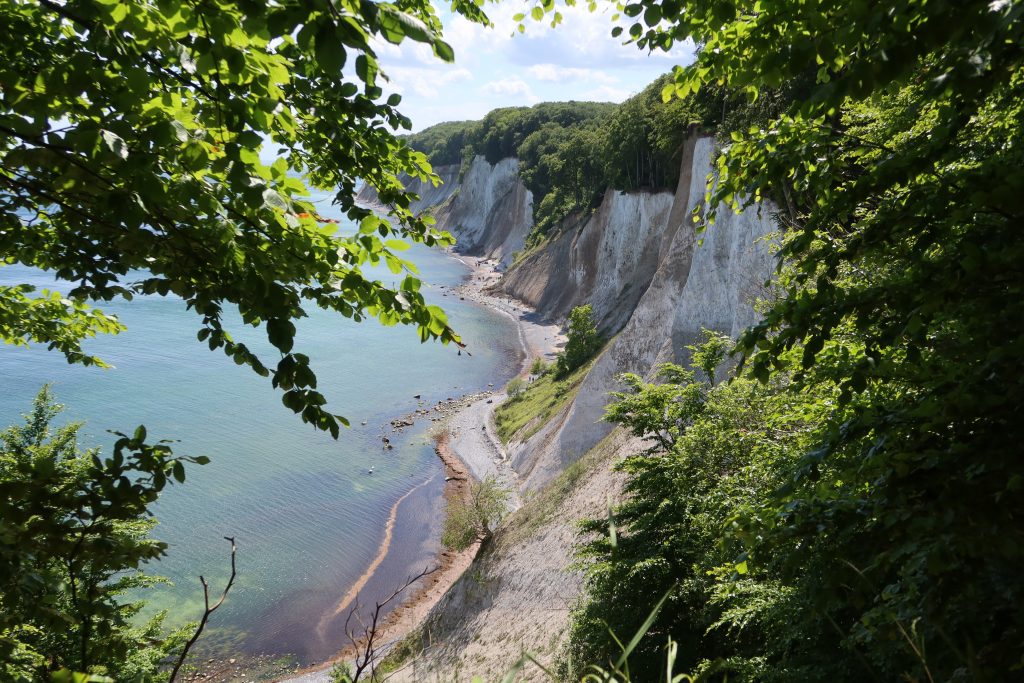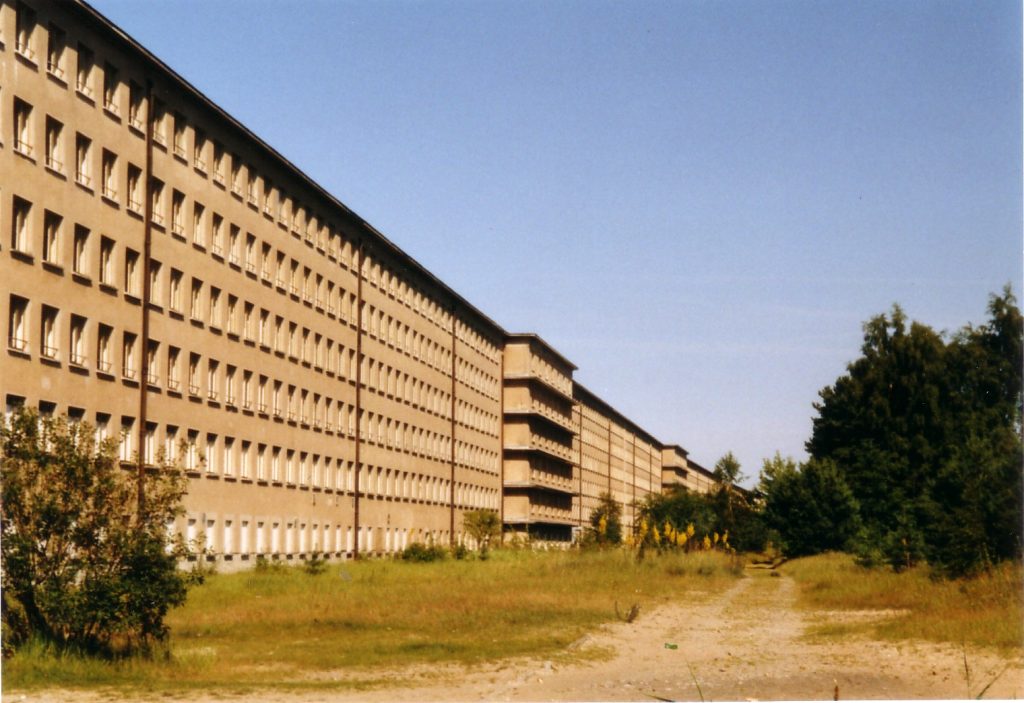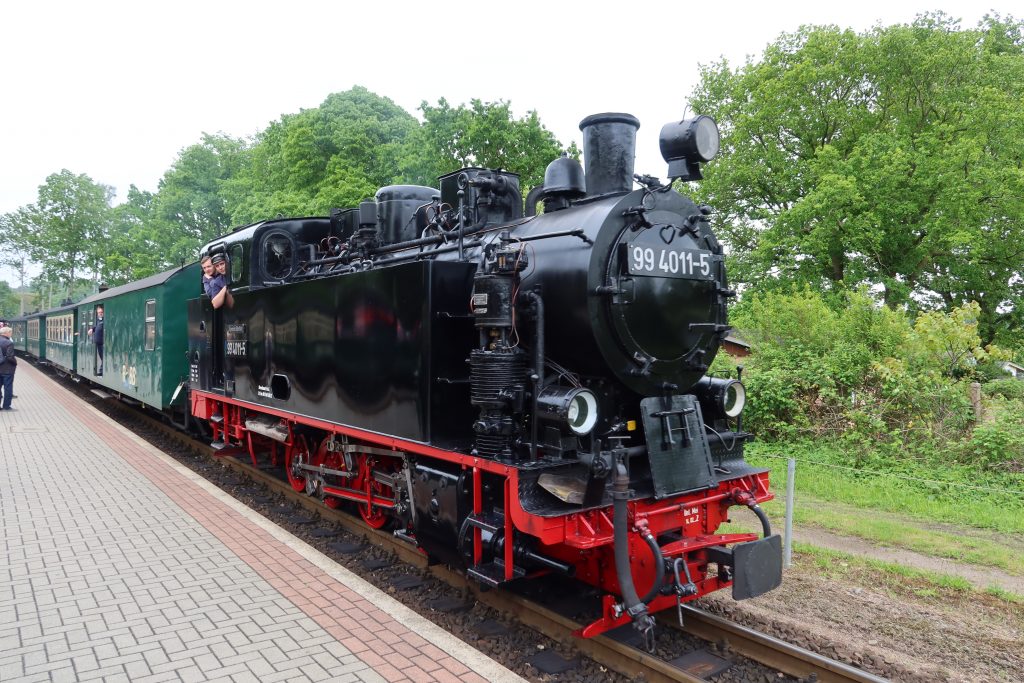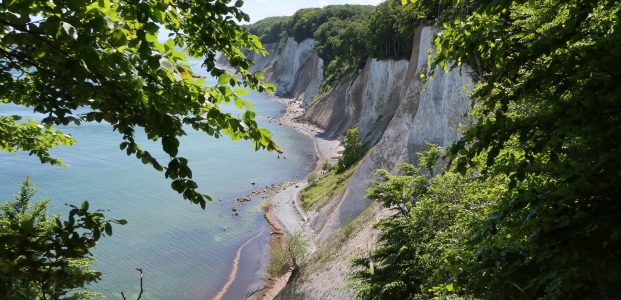We had planned to spend a bit more time exploring around Rügen and various other places in the area, but the weather had other ideas. With several days of strong winds forecast, we decided to head straight round to Sassnitz on the east coast of Rügen. The idea was to shelter there for a few days and see how the weather then changed. So we set off from Lauterbach at 09.35. We had a good sail, but eventually the wind died as we turned NE into the Landtief channel and so reluctantly the engine went on. It stayed on through a half hour rain squall with winds gusting up to 19 knots – mainly because in the rain no-one particularly wanted to do anything other than shelter! However, it cleared again and we moored in between piles at Sassnitz at 15.35.
Sassnitz apparently has the longest outer mole in Europe with a length of 1,450 metres. They started it in 1889 and finally finished in 1912. However, we spent the next couple of days wishing they had carried on for another few years and gone round the corner a bit as the SW winds just managed to funnel nicely through the entrance rolling us around quite a bit in the berth. The snubbers were rediscovered from the depths of the lockers and we tried various permutations and combinations of string and snubbers to try to minimise the movement with moderate success, though it may have been a slight change in wind direction which had the greatest effect.
Sassnitz itself is a popular German holiday resort and so we spent the next couple of days exploring the area. The first day we did a walk around the Jasmund National Park. This is the smallest national park in Germany at just 12 sq miles and though small, it is perfectly formed! The entire area is chalk cliffs and Sassnitz was one of the key areas for the German chalk industry in the 19th century. Competition between firms was intense and eventually they decided enough was enough so in 1889 17 companies with 23 chalk plants merged to form a cartel and control member’s production volumes and prices. After the war, Sassnitz was in East Germany and chalk became a major export item of the GDR. With reunification the industry has continued but the Sassnitz area has seen increasing protection and the National Park is even UNESCO recognised as part of a chain of beech forests. The walk through the park was certainly stunning with some excellent views of the cliffs.

The next day we headed the other way – south. We took the bus to Binz and this route took us directly past the Prora. The Colossus of Prora holds the dubious honour of being the longest hotel in the world. It consisted of eight identical buildings and was 2.8 miles in length running parallel to the beach. The remaining structures still stretch 1.9 miles. You have to hope that the reception for the hotel wasn’t at one end as the walk to your room could have been a long one! The resort was started in 1936 as part of the Kraft durch Freude (‘Strength through joy’) programme. This was founded in 1933 and by1934, 400,000 people took Strength Through Joy package tours. This rose to 1.7 million by 1937, as well as 7 million who availed themselves of weekends away and 1.6 million who participated in organized hikes. By 1939 it was the largest tourism operator in the world though it did have a more sinister intention of preventing dissident and anti-state behaviour as well as trying to compensate for the low wages and loss of workers rights in Nazi Germany. The building of the Prora was a particular pet project of Hitler’s and he envisioned it as a parallel to Butlins. You can’t help thinking though that this makes Butlins look like the home of free-thinking and liberalism. Nevertheless, Hitler planned for the site a Festival Hall which could accommodate all 20,000 guests at the same time, two wave-swimming pools, a cinema and a theatre as well a large dock for passenger ships. With the outbreak of war much of this didn’t happen and building stopped. Most of the 9,000 workers who had been working on site transferred to the V-Weapons plant at Peenemünde and many of the buildings remained an empty shell. Had it been completed it would have been the largest holiday complex in the world. The site remained empty for many years, but since 2010 there has been gradual restoration and many of the blocks are now second homes for people from Hamburg and Berlin. There is also a hotel and youth hostel.

From there we carried on to the Binz Kleiner Bahnhof for a rise on the Rasender Roland train. We had already seen this at Lauterbach Mole very quickly through the trees, so we decided to take the train from Binz through to Putbus. Given the name – Rasender Roland means Racing Roland – we expected a lightning trip through the Rügen countryside watching people and landmarks race past. In fact the reverse was true and as we waved at cyclists racing past us, we realised that the naming of the train was either ironic or done by someone with a very warped sense of humour. Still, there is something very romantic about the smell of a steam train at whatever speed, so we enjoyed the slow train to Putbus …. From there we took a quicker and more modern train back to Sassnitz via Bergen auf Rügen. A very enjoyable day out ….


